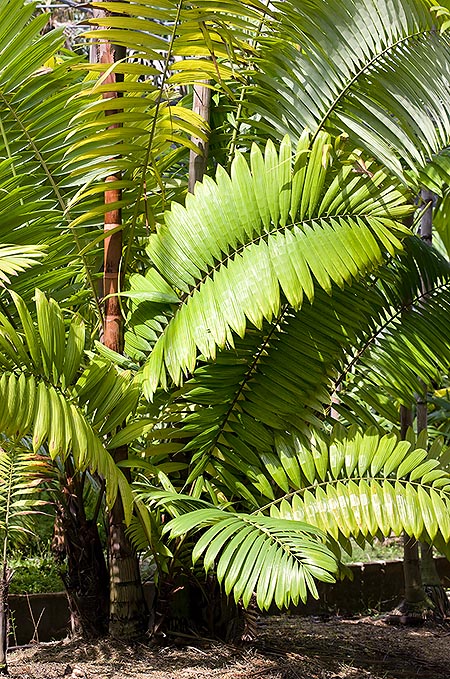Family : Arecaceae

Text © Pietro Puccio

English translation by Mario Beltramini

The Oenocarpus mapora has elegant 3 m leaves with 80 pinnulae © G. Mazza
The name of the genus is the combination of the Greek words “oinos” = wine and “karpόs” = fruit, with reference to the alcoholic beverage obtained from the fruits; the name of the species is the local name used in Venezuela.
Common names: bacaba (Bolivia); bacabai, bacabinha (Brazil); corunto, posuì, pusuy, don Pedrito, donpedrito (Colombia); maquenca, maquenqué, troopas, trupa (Panama); caima, ciamba, siamba, sinamillo (Peru); mapora (Venezuela), bamboo palm, black palm, mapora palm, don Pedrito’s palm (English).
The Oenocarpus mapora H.Karst. (1857) is a moderately caespitose plant, monoeicious, with up to 15 m tall stems with a diameter of 4-15 cm, greyish in the oldest part and on which are evident the rings trace of the junction of the old leaves; nearly always, the tuft does not exceed the number of 12 stems.
The leaves are pinnate, 2-3 m long, with 40-80 pinnulae per side, long up to about 80 cm and 4-5 cm broad, acuminate, of intense green colour on the upper side, blue-green below, regularly disposed but the centre where they are grouped in number of 2 to 5, the foliar base, olive green or dark purple, does not wrap completely the stem; the leaves, at their opening, are of bronze colour.
The inflorescences come out under the leaves, red when in fruit, like a “ponytail”, formed by a short main axis (rachis) from which depart even 100 floriferous branches, up to about 40 cm long, pendulous, with white unisexual flowers united in the characteristic triad (one female flower between two male ones) in the part close to the rachis, and only male flowers in the terminal part.
The inflorescence has the phenomenon of the proterandry (the male organs ripen before the female, thus avoiding the self-fecundation, helping the crossed one).
The fruits are ovoid, 1-2 cm long, dark purple when ripe, and contain one seed only. Usually, it reproduces by seed, which germinates in 2-4 months; in the wild the growth is fast, reaching the maturity in 4-5 years.
Plant which occupies an important position in the life of the local populations, the fruits are consumed cooked and from them they get a good quality oil and an alcoholic beverage, known as bacaba wine, much popular.
Also the buds (palmitos) are consumed without causing problems to the survival of the plant, in fact, the cut stems are replaced in the tuft by the growth of new ones; the stems are also utilized in the construction, the leaves as cover and, intertwined, for various common usage objects. It is a very ornamental palm due to the elegant leaves and the thin stems, but little utilized outside the origin zones; cultivable in the tropical and humid subtropical climate zones, where it seems it can stand, for very short time, rare decreases of the temperature to 0 °C. It needs slight shade when young, when adult, it bears the full sun as well as dry periods, even if it loves constantly humid soils, provided they are draining, preferably sandy.
Synonyms: Oenocarpus multicaulis Spruce (1869); Oenocarpus dryanderae Burret (1933); Oenocarpus panamanus L.H.Bailey (1933); Oenocarpus macrocalyx Burret (1934).
→ For general notions about ARECACEAE please click here.
